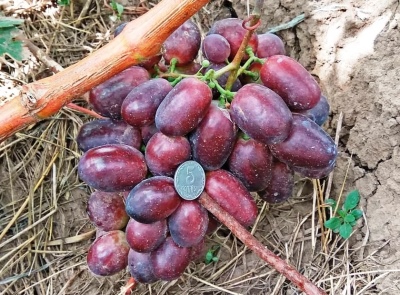
- Authors: Kalugin Viktor Mikhailovich
- Appointment: dining room
- Berry color: dark pink-purple
- Taste: harmonious
- Ripening period: early
- Ripening period, days: 115-120 days
- Frost resistance, ° C: -23
- Bunch weight, g: 15-1200
- Flower type: bisexual
- Peeling: there is a tendency
The Olympus grape may indeed bring horticulturists closer to the Olympus of viticultural success. But for this it is necessary to thoroughly study its features and nuances of application. Both the landing and basic care measures deserve attention.
Breeding history
Olympus is a complex interspecific hybrid. Specific ancestral forms are unknown. The author of the development is an amateur breeder Viktor Kalugin. The variety has been on sale since 2016. There is no more information about its creation.
Description
Ripening period
Olympus table grapes are among the early varieties. He will sing for 115-120 days. Under favorable conditions, fruit ripeness is reached by August. At this point, they are already collecting quite a lot of sugar. Visually, maturity is expressed in darkening.
Bunches
In shape, they are a cross between a cylinder and a cone. The berries are very densely arranged inside the brush. The bunch weight varies widely. Sometimes it reaches 1.2 kg. A pronounced disadvantage of the variety is its susceptibility to peas.
Berries
The fruits of Olympus are painted in a complex color - both dark pink and purple notes can be traced in it. The flesh is quite firm. It differs in both meatiness and juiciness. The fruit itself resembles an elongated oval, rather, even, according to some reviews, a barrel. Overripe grapes acquire a pronounced dark color.
Taste
According to tasters, this type of grape is quite tasty. It leaves harmonious pleasant sensations. There is a certain amount of acidity. There is no need to wait for the nutmeg sensation. However, this does not affect the perception for the worse.
Yield
Due to the relatively small history of the variety, it is still difficult to appreciate it at its true worth. There simply cannot be exact final figures for fertility. However, early ripening gives hope for a consistently high yield. The ability of the bushes to develop quickly is also encouraging. You need to wait a few more years to give the plant a full assessment.


Growing features
Landing
This variety can be planted even in the northern regions of Russia. But there is no reliable information on its landing yet. With caution, it can be assumed that it is permissible to follow the same methods as when growing other early varieties.

Pollination
The flowers of Olympus are bisexual. In any vineyard, even if there are no other plants, it will be able to develop normally.No special efforts are required to attract bees. But, of course, normal pollination is possible only in good weather. Sometimes growers are forced to help their plantings.
Pruning
As already noted, the plant has been little studied. Healing pruning plays a very important role. Thanks to her, the maintenance of good yields is guaranteed for a long time. Special shaping of the bush is hardly necessary.



Frost resistance and the need for shelter
Developers of the variety and sellers of planting material insist that Olympus grapes can stably tolerate cold down to -23 degrees. And yet this is not always enough. In most Russian regions, additional planting insulation is indispensable. You can refuse it only on the Black Sea coast. More details have yet to be collected.

Diseases and pests
The resistance of Olympus to fungal infections is still poorly understood. But there is some evidence that the culture can be considered quite persistent in comparison with other options. Processing, if required, is minimal. No specific pests have been identified. There is reason to believe that they just haven't "tasted" this variety yet.

If a grape is exposed to any disease or insect, this always affects its appearance.
Storage
Basically, the fruits of Olympus are consumed fresh. They can only be stored for a long time in refrigerators. Instead of storing for more than 5 days, it is strongly recommended to recycle the crop. It should be remembered that this is a canteen, not a wine culture.











































































